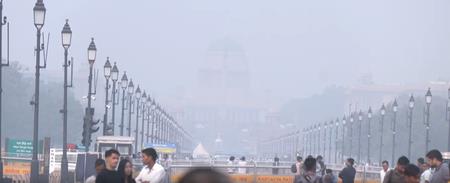
Pollution Levels Spike In Delhi-NCR, Air Quality Slumps To 'Very Poor' Category
The air quality in most parts of Delhi continues to be suffocating. R.K. Puram (335), Rohini (352), Sonia Vihar (350), Wazirpur (377), and Vivek Vihar (373) reported AQIs well above 300 - an indication of severe pollution. Other localities like Sirifort (338), Shadipur (330), and Pusa (333) also showed extremely poor air quality. Across the border, Noida is facing a similar crisis. The AQI at Sector 62 stood at 304, Sector 116 at 306, and Sector 125 at 299 - all hovering around the“very poor” mark.
The situation in Ghaziabad paints an even grimmer picture. Loni registered an AQI of 344, and Vasundhara 358, both falling in the“severe” category. Such toxic air is taking a direct toll on public health. Experts warn that prolonged exposure to this pollution can trigger respiratory ailments, asthma, chronic cough, eye irritation, and severe headaches. Vulnerable groups - including the elderly, children, and pregnant women - have been urged to stay indoors and avoid strenuous outdoor activities.
A dense blanket of smog has settled over the city, making morning and evening commutes perilous. Drivers struggle through dim visibility as the skyline fades into a dull, smoky blur. The Meteorological Department predicts little relief in the coming days, citing slow wind speeds and falling temperatures that are trapping pollutants close to the surface.
Authorities have urged residents to reduce private vehicle use, opt for carpooling or public transport, and strictly follow dust-control measures at construction sites. On Sunday, the national capital's overall AQI stood at 366 - in the“very poor” category - with three stations recording“severe” levels above 400, as per Central Pollution Control Board (CPCB) data.
CPCB figures showed PM2.5 concentrations at 189.6 micrograms per cubic metre and PM10 levels at 316 - both far exceeding safe limits. These microscopic particles, invisible to the eye, silently invade the lungs and bloodstream, posing grave health risks.
According to a recent Global Burden of Disease (GBD) study, air pollution remained Delhi's biggest health threat in 2023, contributing to nearly 15 per cent of all deaths.

Legal Disclaimer:
MENAFN provides the
information “as is” without warranty of any kind. We do not accept
any responsibility or liability for the accuracy, content, images,
videos, licenses, completeness, legality, or reliability of the information
contained in this article. If you have any complaints or copyright
issues related to this article, kindly contact the provider above.


















Comments
No comment